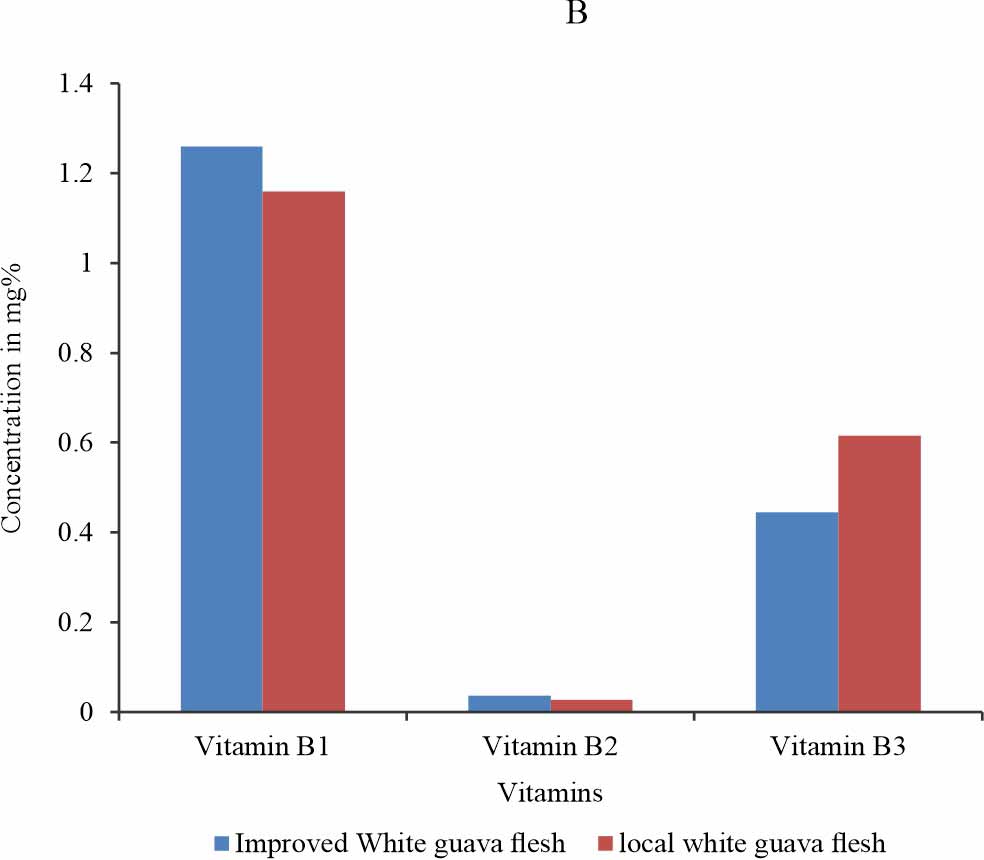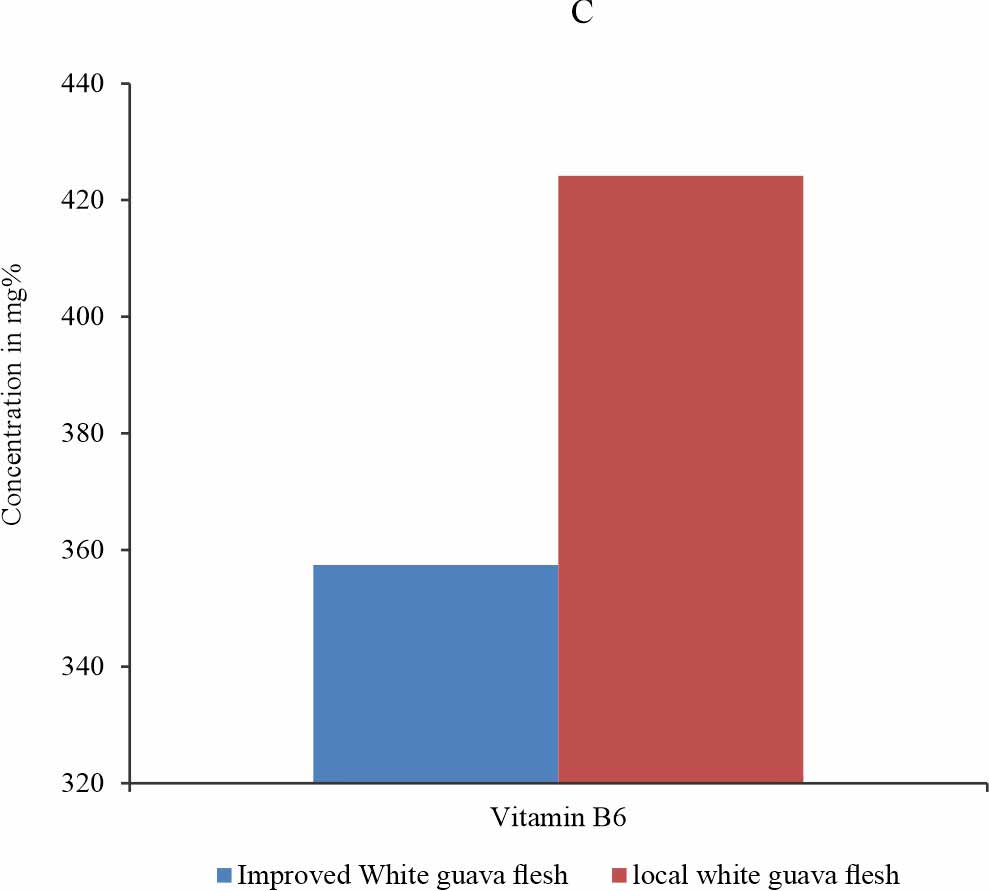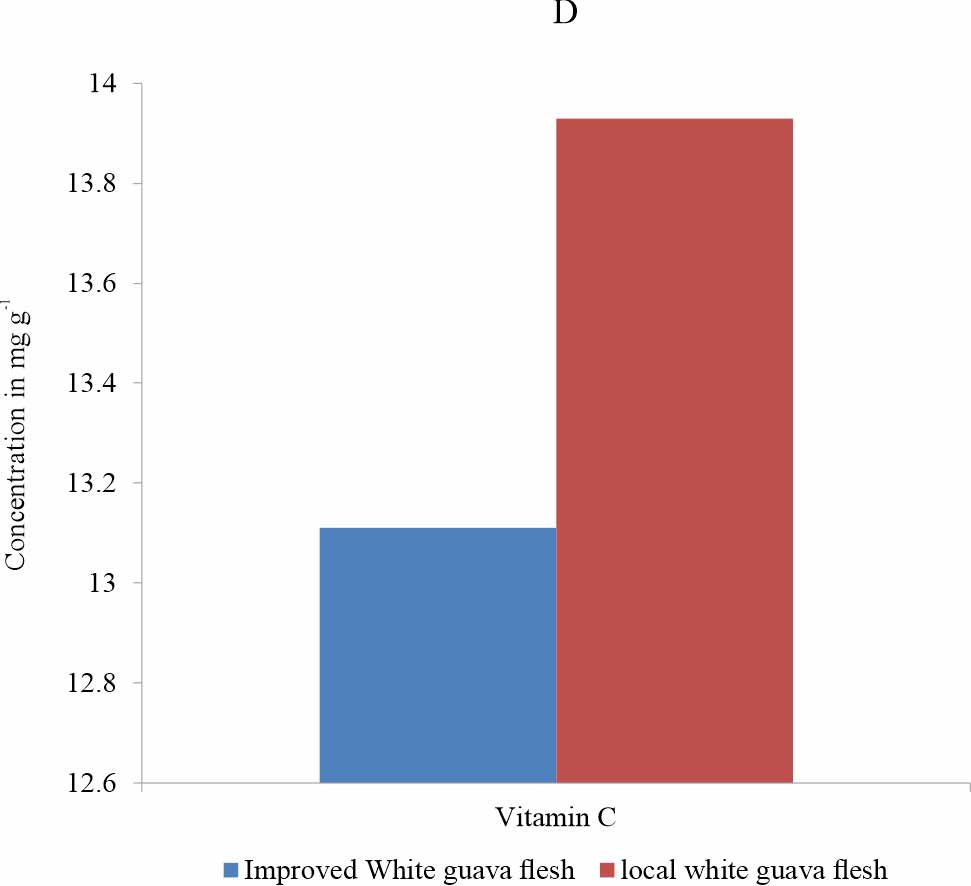Evaluation of Vitamins and Possible Nutrient Composition of Local and Improved Specie of Guava Flesh (Psidium guajava)
| Received 17 Feb, 2021 |
Accepted 12 Apr, 2021 |
Published 15 Jun, 2021 |
Background and Objectives: Guava (Psidium guajava) belongs to the family Myrtaceae. It has been cultivated in Nigeria one of the most common fruits in Nigeria. It has become popular because of its availability almost throughout the year. The objective of this study is to evaluate the nutritional and vitamin contents of the flesh of the local and improved guava species. Materials and Methods: Proximate components were determined using the Association of Official Analytical Chemists (AOAC) method for the moisture, ash, crude lipid and nitrogen content. Crude protein and Carbohydrate. Vitamins A, B1, B2, B3, B6 and B12 were analyzed using standard methods. Results: The result showed that moisture and carbohydrate content of the improved white guava flesh is low compared with the local white guava species (9.8825 and 14.4015%) and (56.378 and 62.802%), respectively. The ash, fat, fibre and protein content of the improved white guava flesh is high compared with the local guava species (11.25 and 5.15%), (5.55 and 1.335%), (6.6145 and 6.5865%) and (10.325 and 8.225%). Improved white guava flesh is relatively low in vitamin A, vitamin B3, vitamin B6 and vitamin C compared to local white guava flesh, while the local white guava flesh is relatively poor in vitamin B1, vitamin B2 and vitamin E compared to improved white guava flesh. Conclusion: The present findings suggest guava flesh as a considerable source of nutrients in the diet and may have health and economic benefits due to its vitamins, and nutritional composition.
INTRODUCTION
There is growing interest and concern among people from all walks of life in foods and their relationship to nutrition and health. Fruits form part of the balanced diet, which the human body need and they are used to prevention deteriorating health condition1.
Guava (Psidium guajava) is one of such fruits and it belongs to the family Myrtaceae. It has been cultivated in Nigeria as one of the most common fruits2 and it’s available almost throughout the year. It also grows well in zones of scanty rainfall areas such as in the north-eastern part of Nigeria3. Psidium guajava is an evergreen shrub with a musky special odour when ripened4. The fruit contains several small seeds and consists of a fleshy pericarp and seed cavity with pulp5.
It contains antibacterial and antimicrobial compounds6 and had shown a high anti-diabetic activity7. Guava contains antioxidants, phytochemicals, essential oils, polysaccharides, minerals, vitamins and enzymes8. Guava is also a very good source of bioactive components. However, in Nigeria, the local breeds (Fig. 1) cultivated by people are being replaced by improved breed (Fig. 2) as a result of the size of the improved breed and pest infestation that commonly attacks the local breeds guava. Thus, this research aims at evaluating the nutritional composition and vitamin contents of the flesh of the local and improved guava species.
 |
||||||
| |
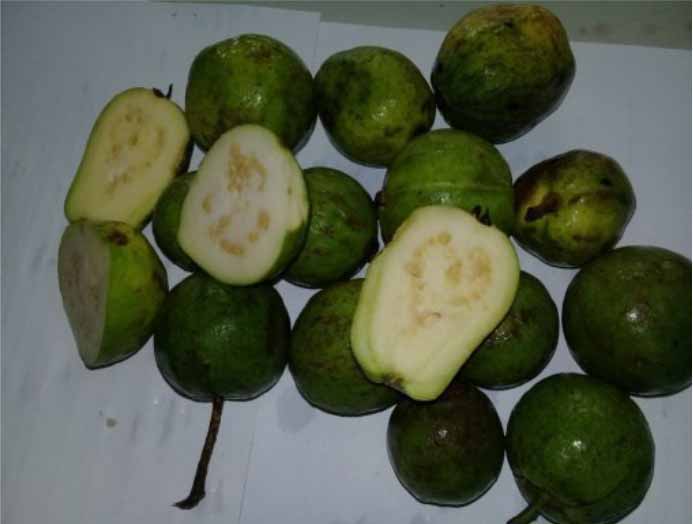 |
||||
| |
MATERIALS AND METHODS Sample collection and preparation: The guava samples were bought from Eke Awka and Eke Amaenyi market both in Awka South local government area, Awka, Anambra State, Nigeria. This research project was conducted from May-June, 2019.
The composite samples of each species of the fruit were prepared separately. Each sample was washed thoroughly with distilled water, cut into smaller sizes and dried in the oven for 5-7 days at 40ºC after which the flesh was ground into a fine powder. The already grounded flesh was transferred into an airtight container and properly labelled for further analysis.
Proximate analysis: The AOAC9 method was used for the determination of moisture, ash, crude lipid, Carbohydrate and nitrogen content.
Vitamins: Vitamins A, B1, B2, B3, B6 and B12 were analyzed using the method described by Bayfield and Cole10, vitamin C and E were analyzed by Kirk and Sawyer11 method.
RESULTS AND DISCUSSION
The results of the proximate analysis in Fig. 3, showed that the improved white guava flesh contains percentages of moisture, ash, fat, fibre, protein and carbohydrate content of 9.8825, 11.25, 5.55, 6.6145, 10.325 and 56.378%, respectively. While local white guava flesh contains percentages of moisture, ash, fat, fibre, protein and carbohydrate content of 14.4015, 5.15, 1.335, 6.5865, 8.225 and 62.802%, respectively.
From the result of the proximate analysis done, the local white guava flesh contains high moisture and carbohydrate content than the improved white guava. While the improved white guava has higher compositions of ash, fat, fibre and protein content than the local white guava flesh. The observed moisture content in both species of guava’s flesh is relatively low compared to (80%) obtained by Ekpete and Edori12. The total carbohydrate and protein content values were higher than those reported by Jyorti et al.13. The leaves equally showed a considerable high concentration of carbohydrate, protein, moisture and crude fibre with relatively low levels of ash and fat14. Guava has a low energy content of 68 kcal/100 g14. El-Buluk et al.15 reported that the crude protein content of guava is low (1%) and high moisture content (6.2-76.0%)16. Lintu et al.17, showed the presence of Carbohydrate (7 mg/100 g), Starch (6.3 mg/100 g) and Protein (16.8 mg/100 g).
A higher level of carbohydrate can give consumers a boost of energy. Being a source of dietary fibre and protein, the guava flesh, especially the improved breed, can be a key to achieving good digestive health. Increased intake of guava in the diet can increase the intake of dietary fibre, which helps to relieve many digestive problems including bloating, stomach cramps, and can be a source of amino acids in the body which helps in the body build-up, cellular regulation and hormonal stimulation which increases the body metabolic rate and helps fight diseases.
 |
||
| |
Vitamins content: The results obtained for vitamin content of the improved White and local white Psidium guajava flesh are shown in Fig. 4a-e. The data of Fig. 4a showed vitamin A and E content of improved and local white guava flesh (3.09 and 6.055 mg kg-1) and (3.265 and 1.0925 mg kg-1) respectively. The data of Fig. 4b showed the vitamin B1, B2, and B3 content of improved and local white guava flesh (1.2581 and 1.1568 mg%), (0.037 and 0.0275 mg%) and (0.4445 and 0.616 mg%) respectively. In Fig. 4c, the vitamin B6 content of improved and local white guava flesh is shown as (357.5 and 424.14 mg%), the vitamin C content of improved and local white guava flesh in Fig. 4d (13.11and 13.925 mg g-1), and vitamin B12 content of improved and local white guava flesh in Fig. 4e, (0.0865 and 0.0875 mg/100 g).
From the result, it was observed that the improved White guava flesh is relatively low in vitamin A, vitamin B3, vitamin B6 and vitamin C compared to local breed flesh, while local white guava flesh has a relatively low content of vitamin B1, vitamin B2 and vitamin E compared to improved breed. Guava can be promoted as a health and quality fruit in taste, texture and overall nutritive quality18. It has been reported to be an excellent source of vitamin C (200±300 mg/100 g)19, niacin, riboflavin and vitamin A20. The fruit contains a large amount of citric, and a trace amount of formic acid21. The plant showed the presence of a high concentration of vitamin C as 103.0 mg/100 g, vitamin B as 14.80 mg/100 g17. Therefore, it entails that guava can be a source to supply these nutrients when consumed.
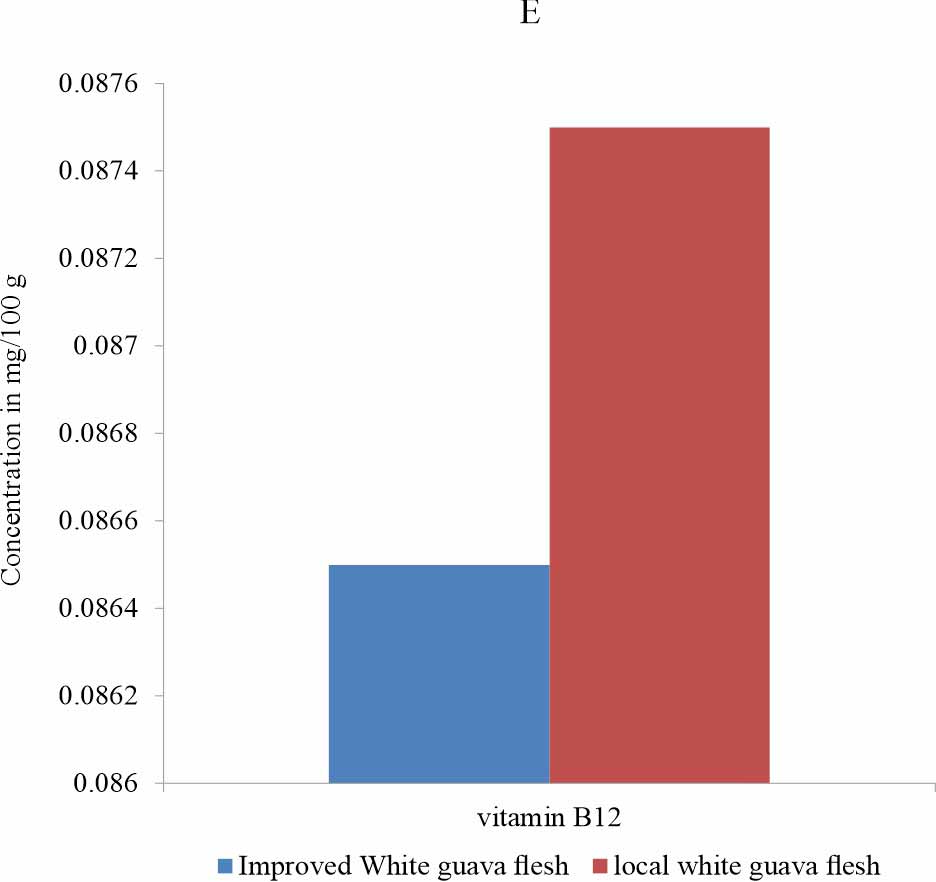 |
| |
CONCLUSION
This study of these two guava species has highlighted the potentials of this fruit to serve as food. It has also shown the importance of the two species most especially the local white guava and that it should not be allowedto go into extinction as its cultivation is gradually declining observed by its reduced availability in the market.
SIGNIFICANCE STATEMENT
This study discovers the guava especially the local white guava species has high nutritive values that can be beneficial for the improvement of the health of its consumers and enhancing the establishment of its industrial products. This study will help the researcher to uncover the critical areas of different species of guava nutritive values that many researchers were not able to explore. Thus a new theory on the production of local white guava species may be arrived at.
REFERENCES
- Waziri, M. and I. Saleh, 2015. Proximate analysis and phytochemical screening of Psidium guajava (guava) and Cucumis sativus (cucumber) grown in Gashua fadama area of Yobe state, Nigeria. Int. Res. J. Pure Appl. Chem., 6: 77-83.
- Misra, K. and T.R. Seshadri, 1968. Chemical components of the fruits of Psidium guava. Phytochemistry, 7: 641-645.
- Lawal, S.H., 2015. Economic analysis of Guava (Psidium guajava) production among small holder farmers in selected local government areas of Kaduna State, Nigeria. Masters Thesis, Ahmadu Bello University, Zaria.
- Morton, J.F., 2013. Fruits of warm climates. Echo Point Books and Media, United States.
- Dakappa, S.S., R. Adhikari, S.S. Timilsina and S. Sajjekhan, 2013. A review on the medicinal plant Psidium guajava linn. (myrtaceae). J. Drug Delivery Ther.
- Rahim, N., D.J. Gomes, H. Watanabe, S.R. Rahman, C. Chomvarin, H.P. Endtz and M. Alam, 2010. Antibacterial activityof Psidium guajava leaf and bark against multidrug resistant vibrio cholera. Jpn J. Infect. Dis., 63: 271-274.
- Rai, P.K., N.K. Rai, A.K. Rai and G. Watal, 2007. Role of LIBS in elemental analysis of Psidium guajava responsible for glycemic potential. Instrum. Sci. Technol., 35: 507-522.
- Naseer, S., S. Hussain, N. Naeem, M. Pervaiz and M. Rahman, 2018. The phytochemistry and medicinal value of Psidium guajava (guava). Clin. Phytosci.
- Williams, S., 1984. Official methods of analysis of the association of official analytical chemists. 14th Edn., AOAC.
- Bayfield, R.F. and E.R. Cole, 1980. Colorimetric Estimation of vitamin A with Trichloroacetic Acid. In: Methods in Enzymology. McCormick, D.B. and L.D. Wright (Eds.). Academic Press, United States pp: 189-195.
- Kirk, R.S., R. Sawyer and H. Egan, 1991. Pearson's Composition and Analysis of Foods. 8th Edn. Addison-Wesley Longman Ltd., United States.
- Ekpete, O.A., S.E. Onisogen and P.E. Fubara, 2013. Proximate and mineral composition of some Nigerian fruits. Br. J. Apll. Sci. Technol., 3: 1447-1454.
- Vora, J.D., G. Mankame and P. Mada, 2018. Biochemical and nutritional assessment of guava (Psidium guajava). IOSR J. Plant Biochem. Biotechnol.
- Offor, C.E., 2015. Phytochemical and proximate analyses of Psidium guajava leaves. J. Res. Pharm. Sci., 2: 5-7.
- El-Bulk, R.E., E.E. Babiker and A.H. El Tinay, 1995. Biochemical and physical changes in fruits of four guava cultivars during growth and development. Food Chem., 54: 279-282.
- Chen, H.C., M.J. Sheu, L.Y. Lin and C.M. Wu, 2007. Nitritional composition and volatile compound in guava. Fresh Produce, 1: 132-139.
- Thomas, L., A.T, Lasyaja AB, M. Suganya, P. Gayathri and S. Chithra, 2017. Biochemical and mineral analysis of the undervalued leaves Psidium guajava L. Int. J. Adv. Sci. Res., 2: 16-21.
- Uddin, M.S., M.N.A. Hawlader, L. Ding and A.S. Mujumdar, 2002. Degradation of ascorbic acid in dried guava during storage. J. Food Eng., 51: 21-26.
- Holland, G., A.A. Welch, D.D. Unwin, D.H. Buss, A.A. Paul and D.A.T. Southgate, 1991. The Composition of Foods. 5th Edn. Royal Society of Chemistry, Campridge, UK.
- Soares, F.D., T. Pereira, M.O.M. Marques and A.R. Monteiro, 2007. Volatile and non-volatile chemical composition of the white guava fruit (Psidium guajava L.) at different stages of maturity. Food Chem., 100: 15-21.
- Alagumani, T., 2005. Economic analysis of tissue-cultured banana and sucker-propagated banana. Agric. Econ. Res. Rev., 18: 81-89.
How to Cite this paper?
APA-7 Style
Oguazu,
C.E., Adimora,
K.H., Anajekwu,
B.A. (2021). Evaluation of Vitamins and Possible Nutrient Composition of Local and Improved Specie of Guava Flesh (Psidium guajava). Asian Journal of Emerging Research, 3(2), 114-117. https://doi.org/10.3923/ajerpk.2021.114.117
ACS Style
Oguazu,
C.E.; Adimora,
K.H.; Anajekwu,
B.A. Evaluation of Vitamins and Possible Nutrient Composition of Local and Improved Specie of Guava Flesh (Psidium guajava). Asian J. Emerg. Res 2021, 3, 114-117. https://doi.org/10.3923/ajerpk.2021.114.117
AMA Style
Oguazu
CE, Adimora
KH, Anajekwu
BA. Evaluation of Vitamins and Possible Nutrient Composition of Local and Improved Specie of Guava Flesh (Psidium guajava). Asian Journal of Emerging Research. 2021; 3(2): 114-117. https://doi.org/10.3923/ajerpk.2021.114.117
Chicago/Turabian Style
Oguazu, C., E., K. H. Adimora, and B. A. Anajekwu.
2021. "Evaluation of Vitamins and Possible Nutrient Composition of Local and Improved Specie of Guava Flesh (Psidium guajava)" Asian Journal of Emerging Research 3, no. 2: 114-117. https://doi.org/10.3923/ajerpk.2021.114.117

This work is licensed under a Creative Commons Attribution 4.0 International License.




